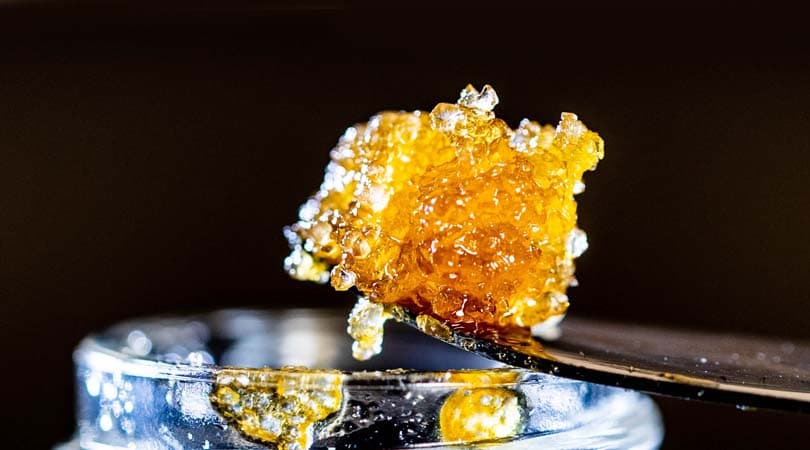Cannabis Culture
Consuming Live Resin the Right Way
While you can smoke live resin, the most common form of consumption is dabbing. Dabbing involves heating the resin to high temperatures, which produces potent effects. It also lets us experience the flavour and aroma profile of the cannabis concentrate.
Since live resin heats up to such high temperatures, it is often not added to joints or bowls. This is because the extreme heat would burn up the plant in a joint or bowl. In addition, the different live resin structures can make it challenging to apply it to a joint or bowl. Without a proper setup, which takes too much time, adding resin to your favourite joint isn’t your best option.
A quick and easy way to get a good taste and potency out of resin is by adding it to your favourite vape pen or standing vaporizer. These methods and tools have the necessary heat capabilities to accentuate the flavours and aromas and make smoking easy. So whether a vape pen or standing vaporizer, vaporizing your resin is a suitable method for a potent high.
Dabbing and resin produce strong intoxicating effects, so you should start with a small dose and work your way up. A small dab can give you an intense high once you understand and are familiar with the feeling. Then try to increase the dose. Starting with a large dosage is the fastest way to suffer an alarming high. So do not underestimate the potency of live resin, even if you are a regular stoner.

Potential Medical Benefits and Uses
Live resin is a great natural solution for pain relief due to its high THC concentration. CBD oils and THC in high levels produce many beneficial medicinal properties. For example, it can act as an anti-inflammatory or an anti-psychotic. The medicinal uses vary widely. Most consumers who use it for medicinal purposes use it to relieve chronic joint or muscle pain. CBD targets the body’s glycine receptors, which send pain signals to the brain. Cannabis binds to these receptors and prevents them from sending those signals; thus, we experience pain intensely.
There are also psychological benefits of live resin. CBD helps with an abundance of disorders like anxiety, depression, PTSD, and sleep disorders. Like how it blocks pain receptors, CBD also blocks receptors in the brain responsible for anxiety or depression. However, THC is like a double-edged sword, meaning too much of it can also induce paranoia or anxiety, so dosing is crucial for THC to be an effective treatment for psychological disorders.
Research is currently underway to determine how higher concentrations affect your overall cannabis experience and health. Early findings suggest that high levels of terpenes have the potential to enhance your cannabis experience and your health. So, the live resin may be the more effective medicine than other concentrates because it lacks high terpene content.
Watch for Side Effects
Live resin has many medical benefits, but the high concentration of THC can also produce some intense side effects. The sheer potency of the high could be the best experience ever, but it can also be overwhelming. Usually, harmful side effects are non-life threatening and derive from user errors like improper doses. In addition, due to the potency and THC concentration, overdosing is relatively easy.
If you hit too big of a dab, expect to feel nauseous or even vomit. However, another commonly reported side effect is paranoia. These cases are rare, especially if the proper dosage is consumed. If you do overdo it, try not to panic. There are no life-threatening effects of a dab overdose. You may just feel sick. It is best to drink water or eat a snack while trying to keep yourself calm. Trying to distract yourself by taking a nap or talking to a friend may help. Remember to remind yourself that the feeling will pass in a couple of hours, and you will feel much better once it does.

Buying Live Resin
Live resin is a tremendous high any stoner would want to try. Luckily, getting ahold of some is easy. You can buy it from most dispensaries or even online. However, be prepared to spend more on live resin than other concentrates. Compared to others, it is considerably more expensive because extracting it is much more difficult. Live resin can be up to 100 dollars per gram. You can find cheaper, less pure alternatives like shatter wax or crumbles at dispensaries for affordable prices, such as those offered at Just Cannabis.
If you can not access a local dispensary, there are plenty of online options for buying live resin in Canada. There are hundreds of online cannabis stores and weed delivery services that sell various products. Most of them also ship all over the country in discreet packages. In addition, you can find a list of trusted dispensaries on platforms such as BCWeedDelivery.
Conclusion
Live resin offers the promise of an incredible high as long as you start small. However, even if you are a regular stoner, doing too much your first time can leave you with a terrible high. To master dabbing, always start small and work your way up. Live resin offers an entirely new experience on your cannabis journey, but your discretion depends on whether it is good or bad.
References
Krauss, Melissa J. (2016, October 1). Displays of dabbing marijuana extracts on YouTube. US National Library of Medicine, National Institutes of Health. Available at: https://www.ncbi.nlm.nih.gov/pmc/articles/PMC4591851/
The National Academies of Sciences Engineering Medicine. (2017). The Health Effects of Cannabis and Cannabinoids. Available at: https://www.nap.edu/catalog/24625/the-health-effects-of-cannabis-and-cannabinoids-the-current-state
Science Direct. (2021, September 29). Tetrahydrocannabinol. Available At: https://www.sciencedirect.com/topics/neuroscience/tetrahydrocannabinol
Grinspoon P MD. (2020, April 10). Medical Marijuana. Harvard Health. Available at: https://www.health.harvard.edu/blog/medical-marijuana-2018011513085
Iffland, Kerstin. (2017, June 1). An Update on Safety and Side Effects of Cannabidiol: A Review of Clinical Data and Relevant Animal Studies. National Library of Medicine, National Center for Biotechnology Information. Available at: https://pubmed.ncbi.nlm.nih.gov/28861514/









